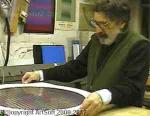Carlos Cruz Diez
Carlos Cruz Diez
Style: Op Art;
Place: Caracas
Born: 1923
Biography:
Carlos Cruz-Diez is a Venezuelan artist considered to be one of the greatest artistic innovators of the 20th and 21st centuries. He is believed to be one of the fathers and greatest figures of kinetic and op art, and has been called a 'master of color' and line, adept at creating fluid, participatory visual experiences. His work invites philosophical conversation on ontology and perception.
His body of work has established him as one of the key 20th-century thinkers in the realm of color. Cruz-Diez’s research has contributed to a new way of understanding color phenomena in art, greatly expanding its perceptual universe. In his works, Cruz-Diez shows that through interaction with the viewer, color becomes an autonomous, evolving reality, devoid of anecdotes, which develops in real time and space.
He has spent his professional career working and teaching between both Paris and Caracas. His work is represented in museums and public art sites internationally, such as Museum of Modern Art (MoMA), New York; Tate Modern, London; Musée d’Art Moderne de la Ville de Paris; Centre Pompidou, París; Museum of Fine Arts, Houston; Wallraf-Richartz Museum, Colonia, and others. He is represented by three American galleries: Sicardi Gallery in Houston, Texas, Moka Gallery in Chicago, Illinois, and Maxwell Davidson Gallery in New York City.
Cruz-Diez was born in Caracas, Venezuela.
Cruz-Diez attended the School of Plastic and Applied Arts in Caracas in 1940 and received a degree in art education and manual arts in 1945. :342
From 1944 to 1945 he worked as a publications designer for Creole Petroleum Corporation. From 1946 through 1951 Cruz-Diez was art director at the McCann Erickson Advertising Agency in Caracas and New York in 1947. :342
In 1957, he returned to Venezuela and worked at his studio, Estudio de Artes Visuales, and started investigating the role of color in kinetic art. He also worked as a graphic designer for the Education Ministry publications, Caracas. During 1958–1960, he served as the Assistant Director and Professor at the Caracas School of Fine Arts. During 1959–60, he also taught Typographie and Graphic Design at the School of Journalism, Central University of Venezuela, Caracas. In 1965, Cruz-Diez the Centre culturel Noroit, Arras, France, as a graphic designer. During 1972–73, he taught Kinetic Techniques at the École nationale supérieure des Beaux-Arts, Paris and Unité d'enseignement et de recherche. From 1973 to 1980, he served as a member of the jury for diploma of École nationale supérieure des Beaux-Arts. From 1986 to 1993, he was the Titular Professor and Director of the Art Unit of the Institute of Advanced Studies (IDEA), Caracas.
During Cruz-Diez's time in school, he studied the work of Georges Seurat and Josef Albers, both artists who experimented with color relationships, aesthetics and perception. While in Europe, he was not only influenced by the Art Movements, he also was influenced by the European surrounding, particularly the plant life, which differed so much from the plant life in his native Venezuela. (concepts of art) He could have, quite possibly been drawn to the variance in color and form. Cruz-Diez is often associated with two Venezuelan Kinetic Artists, Jesús Rafael Soto and Alejandro Otero. All three artists share aesthetic similarities in structure and form, and are considered to have secured Venezuela's position in the international art world. Although Cruz-Diez arrived in Paris ten years after Soto, their national and artistic connections are apparent.
After World War II several Venezuelan artists were able to study abroad, often in Paris. At the same the culture began to change because of industrialization and urbanization, which was directly tied to Venezuela’s exportation of oil. The new challenges faced by the development of modernity presented a receptive audience for Cruz-Diez, which allowed for a break in the traditional artists of Venezuela. (Traditionally painters before 1950) The new cultural climate, which was receptive to the Kinetic Artist, was directly linked to the new technological advancements represented by the Kinetic artists. During 1948–1958 Venezuela existed under a military rule – and the Venezuelan Kinetic artists were often associated with elite social group because they were embraced by the government and supported and commissioned by industry and corporations. Cruz-Diez’s Op Art became popular with the political elite, often because the art lacked any political message.
Cruz-Diez has consistently worked through his career focusing solely on color, line and (viewer) perception. His visual style can be consistently identified throughout his work spanning his entire career. His work contains an element in which the viewer actively participates in viewing the work because the color changes and presents a sensation of movement as the relative position of the viewer changes. Cruz-Diez uses the moiré effect to produce this sensation of motion by his particular composition of lines. Because the image of his work changes as the viewer changes locations, he refers to this changing effect of the image as “vibrations.” In 1959 Cruz-Diez started working in radiation of color, essentially colored light – which is a form of wavelengths, and abandoned paint as a medium. Cruz-Diez often referred to environment and events and part the experience of viewing his art. Because he was working with light and perception, his environment most likely needed to be controlled. Since the perception of the piece changes with the viewer movement, the individual images presented were considered events. Interesting enough these were terms used by the Fluxus group, who were also internationally based, and working around the same time, the late fifties and early sixties.
More...
Wikipedia link: Click Here











